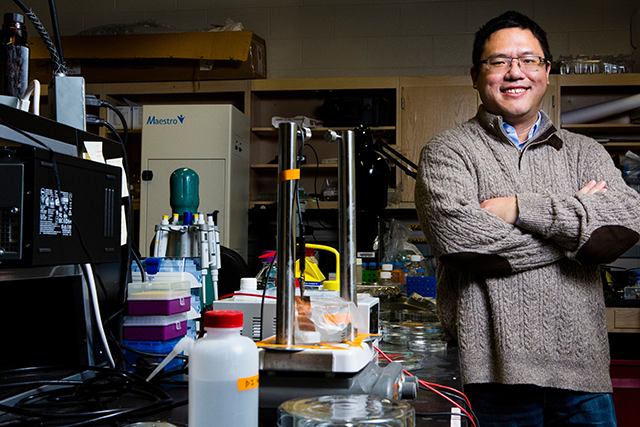Engineering biological systems

By Manisha Aggarwal-Schifellite
In Assistant Professor Xiaocheng Jiang’s lab, understanding and appreciating the complexities of biological systems is essential to engineering improvements for them. “We are going in two major directions,” Jiang says about his lab’s work. “First, we’re looking at how we can design engineering systems to better understand biological processes. Second, we are trying to get some inspirations from biology and develop new materials and approaches for engineering applications.”
Working with undergraduates, graduate students, and postdoctoral scholars in the Tufts University Department of Biomedical Engineering, Jiang is working to help close the gap between biotic and abiotic systems. Integrating these processes could have direct applications in disease diagnostics, brain-machine interfaces, hybrid information processing, and alternative-energy products.
Jiang’s team has developed a hybrid nanoelectronic platform where biocompatible hydrogels are used as interfacing material to overcome a mismatch between solid-state devices and biological systems. Utilizing a custom-built projection stereolithography system, the researchers have observed high-resolution patterning of functional hydrogels on top of various electronic devices, a process that facilitates bio-integration between biological and artificial materials. These observations yield understanding of molecular and cellular processes; at a molecular level, the researchers are improving upon existing methods of biosensing under particular physiological conditions. At a cellular level, the team is using surface-grown, nanometer-thick hydrogels as photosensitive “glues” to immobilize living cells onto multi-electrode arrays.
The Jiang Lab also focuses on finding biological inspiration for engineering processes and applications. Researchers are investigating the behavior of certain bacteria, often found in aquatic sediments, that has the capability to directly transfer electrons from cellular metabolism to external electrode. In the process, the bacteriaconverts organic wastes into electricity. Studying and understanding these evolutionarily developed charge transport systems, Jiang says, is an important step in engineering these microbes as a “cellular factory,” to generate electroactive biomaterials for applications including alternative energy projects.
A third undertaking in the lab has researchers working on developing core/shell bacteria cables as one-dimensional model system to investigate biological charge transport across different length scales. With rationally controlled cell microenvironments, the researchers are able to establish an unambiguous understanding of how the electron transfer occurs in the context of different cellular interactions: situations in which the bacteria are isolated, in close membrane contact, or interconnected via “nanowires.” At the same time, the researchers are developing approaches to optimizing the growth and electrical properties of these biologically produced nanowires, working towards applications in biosensing and electrophysiological recordings. “Overall, we want to learn and provide additional guidance to design and develop new classes of materials that can be used for the next generation of bioelectronic devices,” says Jiang.
Since joining the faculty at Tufts in 2015, Jiang has extensively studied these systems and their biomedical applications—with positive results. He received a National Science Foundation CAREER award for his work on biologically produced, conductive protein nanowires, and an Air Force Office of Scientific Research (AFOSR) Young Investigator Program award for his work on high-resolution bio-imaging using graphene-based microfluidic devices. The Jiang Lab has also served as a place for undergraduate students to get involved in the research world at an earlier stage in their academic lives, working closely with postdocs and Ph.D. students. “We got to look at [Professor Jiang’s] lab in nanobiotechnology clas, to see how things worked,” says Lydia Vignale, E20, who has worked in the lab for a year. “He was very open to showing me what research was like.”
Jiang plans to continue working across disciplines and perspectives to better understand cell-level systems and their role in biotechnology, disease detection, cancer treatment, and drug delivery. “We are establishing the platforms,” Jiang says. “From there, we can do more and go further.”
Department:
Biomedical Engineering